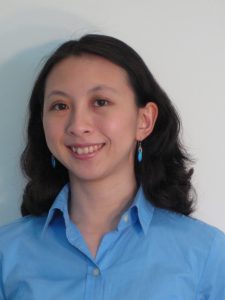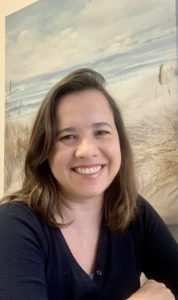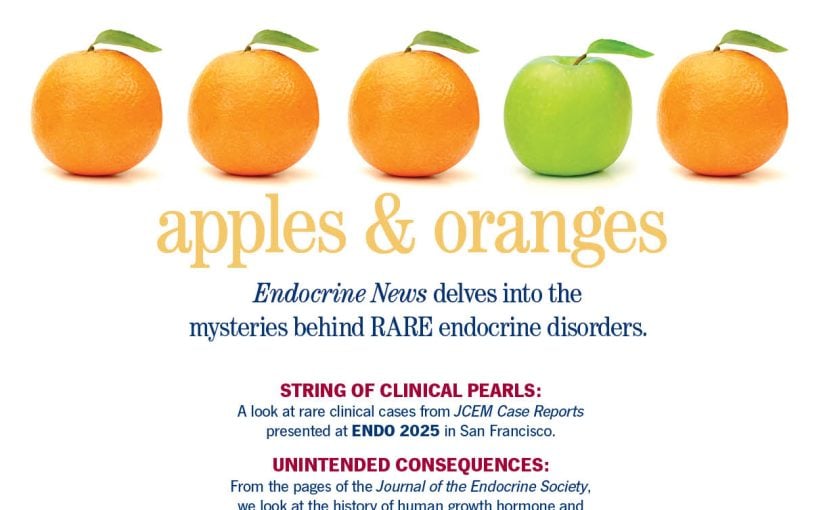ENDO 2021 saw the debut of a new virtual poster competition called the Rising Stars Power Talks where 15 trainees explained their research and took questions from a virtual audience. Endocrine News catches up with the winners to learn more about their research, their future plans, and more.
When ENDO 2021 took place last month, it became the first all-virtual annual conference in the Endocrine Society’s history and took distance learning to new heights that will change the course of scientific conferences forever.
Aside from an ENDO that featured virtual versions of the elements attendees have come to expect — hot topics, energetic debates, world-renowned speakers, career guidance seminars, a virtual “information booth,” and much, much more — there was also a brand new feature that launched this year: The Rising Stars Power Talks.
This poster presentation functioned much like the highly popular Knock-Out Rounds from years past, but in a virtual environment. Fifteen trainees with one slide presentation were given three minutes to present their research and why it is significant, followed by short Q & A session. This rapid round science communication competition highlighted the top scored abstracts from the 2021 Outstanding Abstract Award winners and was hosted by the Endocrine Society’s Trainee and Career Development Core Committee (TCDCC).
The event was moderated by Katja Kiseljak-Vassiliades, DO, University of Colorado Denver, Aurora, Colo., and Erik Russell Nelson, BSc, PhD, University of Illinois at Urbana-Champaign, Champaign, Ill., who both serve on the TCDCC. “This session provides a great opportunity for the early-stage researchers to present their latest science to the broader community in a fun format,” Nelson says. “It also exposes established investigators to the creativity and cutting-edge approaches these rising stars are using.”
The event gave the participants an opportunity to enhance their communication skills and showcase their research as well as receive invaluable feedback in a fast and fun competition. Since research presentations are fundamental to a scientist’s development, participants were encouraged to present the substance of their research and its significance in such a way that can be understood by a broad scientific audience.
“Despite significant efforts to date, the cause of IrAE remains unknown. To design next generation immunotherapies with less toxicity but preserved anti-tumor effects, we must determine the cause of IrAE.” – Melissa G. Lechner, MD, PhD, Assistant Professor of Medicine, Onco-Endocrinology Program, Division of Endocrinology, Diabetes, and Metabolism, Jonsson Comprehensive Cancer Center, UCLA David Geffen School of Medicine, Los Angeles, Calif.
According to Kiseljak-Vassiliades, the idea of Rising Stars Power Talks really came from one of Endocrine Society favorite events, Knock-Out Rounds, but converted to digital setting. “The event showcases a select group of outstanding poster award winners – Endocrine Society Rising Stars,” she says. “Presenting a research project in three minutes is a challenge even for most seasoned scientists and our early-career presenters are up for the challenge. In the spirit of a challenge there will also be a competition and awards. It was a must-see event!”
There were two people’s choice winners were Janet Chiang, MD, University of California, San Francisco; San Francisco Veterans Affairs Health Care System, San Francisco, Calif., and Melissa G. Lechner, MD, PhD, UCLA Geffen School of Medicine, Los Angeles, Calif., and were chosen by the almost 200 attendees who tuned into the debut Rising Stars Power Talks.
The three winners scored by the judges from the TCDCC were: First Place: Rachel V. L. Gonzalez, BS, University of Illinois at Urbana-Champaign, Urbana, Ill.; Second Place: Maria Cristina Foss de Freitas, MD, PhD, University of Michigan, Ann Arbor, Mich.; and Third Place: Leticia M. de Souza Cordeiro, PhD, University of Rochester, Rochester, N.Y.
They all took time out of their ENDO 2021 schedules to talk to Endocrine News about their research, why they chose it, and their future research plans.
“In our clinical practice, we often encounter older males with osteoporosis who have sustained fragility fractures which are associated with increased morbidity and mortality. Osteoporosis in older males is often under-recognized and under-treated. We hope to improve the screening and treatment of osteoporosis in older men.” – Janet Chiang, MD, Division of Endocrinology, San Francisco VA Medical Center, Zuckerberg San Francisco General Hospital, University of California, San Francisco, Calif.
Endocrine News: Tell us a little bit about the research that you presented at the session.
Melissa G. Lechner, MD, PhD: Our research evaluates the cause of thyroid immune-related adverse events (IrAE) occurring during immune checkpoint inhhibitor cancer treatment using a newly developed mouse model and translational studies in cancer patients. We identified a population of T cells that contribute to the development of IrAE. Furthermore, by blocking a key cytokine produced by these cells, we were able to reduce the incidence of IrAE during ICI treatment in a preclinical model. This holds great promise for potential therapy to reduce endocrine IrEA in checkpoint inhibitor treated cancer patients.
Janet Chiang, MD: The aim of our study was to better diagnose and treat older men who have osteoporosis and are at high risk of hip fractures. We used biomechanical computed tomography, (BCT), a technology that is applied to any hip-containing CT scans, such as abdominal CTs to give us 2 measurements: 1. A femoral bone strength estimated by finite element analysis (fragile bone strength has been shown to be independently associated with incident hip fractures in men) and 2. the DXA-equivalent femoral neck bone mineral density T-score. We evaluated the use of BCT in men 65 and older with hip-containing CT scans at the SF VA over a two-year period. We ultimately performed BCT analysis on 557 scans; we reviewed the electronic health records for each man; we then calculated the 10-year probability of hip fracture by FRAX using the clinical data from chart review and the femoral neck T-score from BCT. We then categorized men into high risk and low risk for hip fractures based on their FRAX scores. We found that of the men who had fragile bone found on BCT, around 40% are found to have T-score of >-2.5. Of those who have T-score of >-2.5, 30% have a low fracture risk by FRAX and these men would typically not be offered pharmacological treatment despite having fragile bone.
Maria Cristina Foss de Freitas, MD, PhD: Familial partial lipodystrophy (FPLD) is a rare disease characterized by selective loss of peripheral subcutaneous fat, usually associated with dyslipidemia and diabetes mellitus. Currently, there are no approved specific therapies for this disease in the U.S. On the other hand, Angiopoietin-like 3 is a glycoprotein secreted by the liver that inhibits lipoprotein lipase and endothelial lipase activity, two key enzymes involved in the metabolism of triglyceride-rich lipoproteins and HDL leading to an increase in VLDL-triglyceride secretion. Individuals with homozygous loss-of-function mutations in angiopoietin-like 3 have enhanced LPL activity and present with a hypolipidemic phenotype and render protection from atherosclerosis.
An ASO targeting ANGPTL3 mRNA, called Vupanorsen, has recently caused a significant reduction in ANGPTL3 and triglycerides levels in individuals with diabetes mellitus, hepatic steatosis and hypertriglyceridemia. Given all the data together, we hypothesized that the reduction of ANGPT3 levels could reduce hypertriglyceridemia and associated metabolic abnormalities in FPLD patients. Then we proposed this proof-of-concept, phase 2, open-label study aiming to address the efficacy and safety of vupanorsen in patients with FPLD.
Our study showed that vupanorsen may have a beneficial impact on controlling hypertriglyceridemia and other metabolic abnormalities observed in patients with FPLD.
Rachel V. L. Gonzalez, BS: My study focuses on the consequences of exposure to a water disinfection byproduct (DBP), iodoacetic acid (IAA), on the hypothalamus and pituitary and, more specifically, on their roles in regulating reproduction. DBPs result from unintended reactions between chemicals used to disinfect water, such as are used in public water treatment plants, and substances present in the water. There is epidemiological evidence linking exposure to these byproducts with specific reproductive dysfunction and prior in vitro rodent data shows they can be cyto- and genotoxic in ovarian-derived cells, as well as can disrupt ovarian folliculogenesis and estradiol synthesis. These findings point to the potential for IAA to act as a reproductive toxicant. Despite the hypothalamus and pituitary being important components of reproductive regulation, there was previously very little information about how IAA would affect these tissues. We aimed to address that gap with our study.
Leticia M. de Souza Cordeiro, PhD: Our recently published research indicated that renal GLUT2, a major glucose transporter involved in glucose reabsorption, could be a potential target to treat diabetes by elevating glycosuria (De Souza Cordeiro et al. Diabetologia, 2021). Based on these exciting data, we generated a new mouse model with loss of function of kidney-specific GLUT2 to unravel the role of this glucose transporter in systemic glucose homeostasis. The kidney-specific Glut2 KO mice exhibited massive glycosuria and improved glucose tolerance. Moreover, SGLT2 inhibition further increased glycosuria and improved glycemia in the kidney-specific Glut2 KO mice. In summary, our research indicates that blocking renal GLUT2 may reverse hyperglycemia in diabetes.
“Conducting studies in rare diseases is not always easy; the
difficulties arise from the recruitment of affected individuals and clear delineation of possible side effects, as the natural history of the disease is not always completely known. However, it is always very rewarding and stimulating since new knowledge remains to be discovered.” – Maria Cristina Foss de Freitas, MD, PhD, Postdoctoral Research Fellow, Metabolism, Endocrinology and Diabetes Division, Internal Medicine Department, University of Michigan, Ann Arbor, Mich.
EN: What inspired you to undertake this specific research?
Lechner: Immune checkpoint inhibitor therapy has revolutionized the treatment of advanced cancers and is now first line for metastatic renal, bladder, head and neck, liver, and certain lung, colon, and breast cancers. However, the use and benefits of checkpoint inhibitors are limited by the frequent development of autoimmune toxicities in up to 60% of patients treated with combination anti-PD-1 and anti-CTLA-4 therapy and nearly 30% of patients treated with monotherapy. Endocrine organs are one of the most common tissues affected by these toxicities, termed immune related adverse events (iRAE) and lead to permanent organ dysfunction, interruptions in cancer treatment, and hospitalizations. Despite significant efforts to date, the cause of IrAE remains unknown. To design next generation immunotherapies with less toxicity but preserved anti-tumor effects, we must determine the cause of IrAE.
Chiang: Part of my clinical work has been with male veterans at the San Francisco VA Medical Center. In our clinical practice, we often encounter older males with osteoporosis who have sustained fragility fractures which are associated with increased morbidity and mortality. Osteoporosis in older males is often under-recognized and under-treated. We hope to improve the screening and treatment of osteoporosis in older men.
Foss de Freitas: My inspiration for this project was the possibility of being able to help bring some therapeutic alternatives for patients with FPLD. Conducting studies in rare diseases is not always easy; the difficulties arise from the recruitment of affected individuals and clear delineation of possible side effects, as the natural history of the disease is not always completely known. However, it is always very rewarding and stimulating since new knowledge remains to be discovered.
Gonzalez: My university has a very active and collaborative environment for toxicology research and thanks to pioneering work from faculty here, we had a strong foundation to build from in trying to address this question. DBP exposure is understudied, yet highly relevant to the general public. Since the majority of citizens, at least in the U.S., get their water from a public supply, the risk of exposure is high. Given evidence DBPs may be harmful to health, we wanted to better understand the consequences of exposure at a basic science level and contribute to a body of research that could inform regulatory and personal health decisions about minimizing and mitigating risks. This topic was especially compelling to me because I am passionate about research that considers the biological underpinnings of health contexts and ultimately, my hope is that pursuing such research can lead to improvements in human health.
de Souza Cordeiro: My family has a history of diabetes and, as a nutritionist, I had the opportunity to consult a lot of patients with diabetes. My goal was always to help them to achieve the best control of blood glucose levels. However, I often saw the difficulty of regulating glucose levels. Therefore, I started reading articles in this specific research area, and I became more passionate about better understanding how molecular mechanisms are involved in the control of glucose homeostasis.
“I am passionate about research that considers the biological underpinnings of health contexts and ultimately, my hope is that pursuing such research can lead to improvements in human health.” – Rachel V. L. Gonzalez, BS, PhD candidate, University of Illinois, Urbana-Champaign, Champaign, Ill.
EN: How did it feel to present your work in a virtual environment?
Lechner: I was grateful to be able to present my work at the Endocrine Society meeting despite ongoing travel restrictions and infection concerns with SARS-CoV2. I look forward to a return to in person meetings in the coming year.
Chiang: It was a novel experience that demonstrates the ability of the Endocrine Society to adapt in this pandemic. I’ve learned quite a bit how to prepare and practice a talk using Zoom, how to engage an audience without having live feedback, and how to best utilize audio/video to share our research.
Foss de Freitas: Presenting in a virtual environment was very challenging because you cannot see how people are receiving your message, and there is always the risk of having some technical problem. However, the organizers of the session were very friendly and helped make the presenters comfortable. Definitely, the hardest thing was making a 27-week study fit in a three-minute presentation.
Gonzalez: There were, of course, downsides; I miss meeting researchers in person and being able to have a dialogue with them about our work. During a non-virtual meeting, I may have been able to speak with someone who heard the talk afterwards, provide them more information, and hear their ideas and recommendations about the future of the project in a more naturalistic way. Plus, it is just nice from a social perspective; I missed out on spending time with my friends and science role models. However, there were also upsides. I found my nerves weren’t quite as high as speaking in person because, in some ways, it was a lot like speaking I do more regularly, such as during a lab meeting or at a seminar for my program. Additionally, it was really helpful to be able to type answers to questions for which there wasn’t time during the Q and A portion. Overall, I am glad in-person meetings are on the horizon, but I’m also grateful for the benefits the virtual environment provided.
de Souza Cordeiro: I felt excited and honored by the opportunity to present our research at ENDO 2021 and show the clinical relevance of renal GLUT2 as a potential target to treat diabetes. It was my first experience presenting at a virtual conference and to be able to share this research with others during this difficult time was very special for me.
“My family has a history of diabetes and, as a nutritionist, I had
the opportunity to consult a lot of patients with diabetes. My goal was always to help them to achieve the best control of blood glucose levels. However, I often saw the difficulty of regulating glucose levels. … I started reading articles in this specific research area, and I became more passionate about better understanding how molecular mechanisms are involved in the control of glucose homeostasis.” – Leticia M. de Souza Cordeiro, PhD, Department of Medicine: Endocrinology, Diabetes, and Metabolism, University of Rochester, Rochester, N.Y.
EN: What’s next for you and your research? Where do you go from here?
Lechner: Over the next year, we will continue our research into the cause of endocrine IrAE in patients treated with checkpoint inhibitor therapy. This includes ongoing clinical trials at UCLA and our partner institution USC in patients and preclinical trials evaluating inhibitors of IrAE in the setting of ICI treatment in tumor models.
Chiang: We are interested in expanding our research to further explore the proportion of men who have fragile bone with normal or osteopenic bone density and low FRAX score. We would like to learn more about the clinical characteristics of these men, learn if they respond better to certain osteoporosis therapeutics, and learn if we can better prevent hip fractures in this population.
Foss de Freitas: The first step is to publish our data, and this is on the way. Second, we are planning on jumping in deeper and understanding the mechanism involved in the results we observed. After that, we expect that the new findings will open new avenues.
Gonzalez: The presented research is in the final stages of preparation to be submitted for publication. We intend to continue to pursue this topic, including looking at additional contexts for IAA exposure such as during development. There are also number of mechanistic unknowns when it comes to IAA’s influence that would be really interesting to better understand. Personally, I am in the end stages of my PhD and hope to defend in the coming months. After that, I plan to continue on to a postdoctoral position, though at this exact moment I am not certain where that will be!
de Souza Cordeiro: My career goal is to become an established researcher at a renowned research-intensive institution in the U.S. in the field of diabetes and obesity. For our research, the future goal is to use kidney-targeted carriers, such as (KKEEE)3K peptide, to deliver GLUT2 inhibitors specifically to the kidneys without affecting the transporter in other tissues and thereby minimizing side-effects. This approach will significantly enhance the specificity and efficacy of blocking kidney-specific GLUT2 to treat diabetes.
This event was made possible with support from Radius Health, Inc. and Strongbridge Biopharma.
-Newman has been the editor of Endocrine News since 2013.

 “Despite significant efforts to date, the cause of IrAE remains unknown. To design next generation immunotherapies with less toxicity but preserved anti-tumor effects, we must determine the cause of IrAE.” –
“Despite significant efforts to date, the cause of IrAE remains unknown. To design next generation immunotherapies with less toxicity but preserved anti-tumor effects, we must determine the cause of IrAE.” –  “In our clinical practice, we often encounter older males with osteoporosis who have sustained fragility fractures which are associated with increased morbidity and mortality. Osteoporosis in older males is often under-recognized and under-treated. We hope to improve the screening and treatment of osteoporosis in older men.”
“In our clinical practice, we often encounter older males with osteoporosis who have sustained fragility fractures which are associated with increased morbidity and mortality. Osteoporosis in older males is often under-recognized and under-treated. We hope to improve the screening and treatment of osteoporosis in older men.” difficulties arise from the recruitment of affected individuals and clear delineation of possible side effects, as the natural history of the disease is not always completely known. However, it is always very rewarding and stimulating since new knowledge remains to be discovered.”
difficulties arise from the recruitment of affected individuals and clear delineation of possible side effects, as the natural history of the disease is not always completely known. However, it is always very rewarding and stimulating since new knowledge remains to be discovered.” “I am passionate about research that considers the biological underpinnings of health contexts and ultimately, my hope is that pursuing such research can lead to improvements in human health.”
“I am passionate about research that considers the biological underpinnings of health contexts and ultimately, my hope is that pursuing such research can lead to improvements in human health.” the opportunity to consult a lot of patients with diabetes. My goal was always to help them to achieve the best control of blood glucose levels. However, I often saw the difficulty of regulating glucose levels. … I started reading articles in this specific research area, and I became more passionate about better understanding how molecular mechanisms are involved in the control of glucose homeostasis.”
the opportunity to consult a lot of patients with diabetes. My goal was always to help them to achieve the best control of blood glucose levels. However, I often saw the difficulty of regulating glucose levels. … I started reading articles in this specific research area, and I became more passionate about better understanding how molecular mechanisms are involved in the control of glucose homeostasis.”